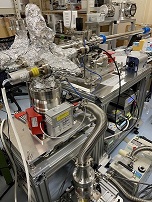Speaker
Description
Muon probing hydrogen study is based on the fact that the target material contains at least a small amount of hydrogen. Therefore, a high-sensitivity measurement of hydrogen abundance would be useful as a complementary measurement of $\mu$SR experiments. We are developing a high-sensitivity thermal desorption spectrometry (TDS) system to perform such complementary measurements.
TDS is known as a method to evaluate the hydrogen abundance in a material$^1$. The principle is that a sample is heated in an ultra-high vacuum, the partial pressure of the released gas is measured with a quadrupole mass spectrometer, and the gas abundance is quantitatively evaluated by integrating the spectrum. Recently, the development of a TDS system that detects hydrogen with a high sensitivity of 10$^{16}$ atoms cm$^{-3}$, the highly hydrogen sensitive TDS (HHS-TDS) system, was reported$^{2,3}$. Our system is a modified version of this HHS-TDS system suitable for complementary measurements of $\mu$SR experiments.
While a conventional TDS system consists of a stainless steel UHV chamber, the HHS-TDS system consists of a chamber made of Be-Cu alloy. This alloy, which has a precise composition of Be$_{0.2}$Ni$_2$Ag$_{0.1}$Zr$_{0.2}$Cu$_{97.5}$, is suitable as a chamber material because of its good thermal conductivity, low hydrogen solubility, and hardness to form a vacuum flange$^4$. In our system, the sample geometry was designed to allow measurement of thin-film substrates mounted on a flag-style sample holder, which is to make the measurement compatible with experiments using ultra-slow muons. We will report on the commissioning of the vacuum chamber and the infrared laser of the TDS system.

1) J. B. Taylor and I. Langmuir, Phys. Rev. 44, 423 (1933).
2) T. Hanna et al., Rev. Sci. Instrum. 88, 053103 (2017).
3) K. Iwaya et al., Materials research meeting 2021, E5-O1-02, Yokohama, Japan, 2021.
4) https://www.toel.co.jp/

